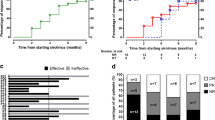Abstract
For patients with pure red cell aplasia (PRCA), cyclosporine (CsA) is the first line therapy. Occasionally, some patients who suffer from renal insufficiency cannot tolerate CsA. To explore the efficacy and tolerance of sirolimus treatment for those patients, twelve PRCA patients with renal insufficiency from May 2014 to May 2018 in Peking Union Medical College Hospital were enrolled, treated with sirolimus, and followed up at the median time of 16 (10–50) months. Eleven patients (91.7%) responded to sirolimus, with 58.3% complete response (CR) and 41.7% partial response (PR). The median time to achieve the optimum effect was 4 (1–7) months. The serum creatinine level remained stable or even reduced during the treatment period for eleven patients. Seven patients (58.3%) reported adverse events during sirolimus therapy, including increased blood glucose, infection, skin rash, elevated triglyceride or total cholesterol, and elevated serum creatinine compared with baseline. No treatment-related death was noticed during the follow-up time. Three patients relapsed with an overall response rate of 75.0% at 1 year. These results suggested that sirolimus was effective and tolerable for patients with PRCA complicated with renal insufficiency.
Similar content being viewed by others
References
Sawada K, Fujishima N, Hirokawa M (2008) Acquired pure red cell aplasia: updated review of treatment. Br J Haematol 142:505–514. https://doi.org/10.1111/j.1365-2141.2008.07216.x
Means RT (2016) Pure red cell aplasia. Blood 128:2504–2509. https://doi.org/10.1182/blood-2016-05-717140
Lippman SM, Durie BG, Garewal HS, Giordano G, Greenberg BR (1986) Efficacy of danazol in pure red cell aplasia. Am J Hematol 23:373–379
Sawada K, Hirokawa M, Fujishima N et al (2007) Long-term outcome of patients with acquired primary idiopathic pure red cell aplasia receiving cyclosporine A. A nationwide cohort study in Japan for the PRCA Collaborative Study Group. Haematologica 92:1021–1028
Burdmann EA, Andoh TF, Yu L, Bennett WM (2003) Cyclosporine nephrotoxicity. Semin Nephrol 23:465–476
Auner HW, Wölfler A, Beham-Schmid C, Strunk D, Linkesch W, Sill H (2002) Restoration of erythropoiesis by rituximab in an adult patient with primary acquired pure red cell aplasia refractory to conventional treatment. Br J Haematol 116:727–728
Zecca M, De Stefano P, Nobili B, Locatelli F (2001) Anti-CD20 monoclonal antibody for the treatment of severe, immune-mediated, pure red cell aplasia and hemolytic anemia. Blood 97:3995–3997
Kochethu G, Baden HS, Jaworska E, Chang J, Chopra R (2005) Reduced intensity conditioning bone marrow transplantation for pure red cell aplasia: successful outcome but difficult post transplant course. Bone Marrow Transplant 36:81–82. https://doi.org/10.1038/sj.bmt.1704993
Sehgal SN (2003) Sirolimus: its discovery, biological properties, and mechanism of action. Transplant Proc 35:7S–14S
Zeng H, Chi H (2017) mTOR signaling in the differentiation and function of regulatory and effector T cells. Curr Opin Immunol 46:103–111. https://doi.org/10.1016/j.coi.2017.04.005
Sukhbaatar N, Hengstschläger M, Weichhart T (2016) mTOR-mediated regulation of dendritic cell differentiation and function. Trends Immunol 37:778–789. https://doi.org/10.1016/j.it.2016.08.009
Johnson RWG (2002) Sirolimus (Rapamune) in renal transplantation. Curr Opin Nephrol Hypertens 11:603–607. https://doi.org/10.1097/01.mnh.0000040045.55337.97
Ventura-Aguiar P, Campistol JM, Diekmann F (2016) Safety of mTOR inhibitors in adult solid organ transplantation. Expert Opin Drug Saf 15:303–319. https://doi.org/10.1517/14740338.2016.1132698
Bride KL, Vincent T, Smith-Whitley K, Lambert MP, Bleesing JJ, Seif AE, Manno CS, Casper J, Grupp SA, Teachey DT (2016) Sirolimus is effective in relapsed/refractory autoimmune cytopenias: results of a prospective multi-institutional trial. Blood 127:17–28. https://doi.org/10.1182/blood-2015-07-657981
Cayrol J, Garrido Colino C (2017) Use of sirolimus (Rapamycin) for treatment of cytopenias and lymphoproliferation linked to autoimmune lymphoproliferative syndrome (ALPS). Two case reports. J Pediatr Hematol Oncol 39:e187–e190. https://doi.org/10.1097/MPH.0000000000000785
Jasinski S, Weinblatt ME, Glasser CL (2017) Sirolimus as an effective agent in the treatment of immune thrombocytopenia (ITP) and Evans syndrome (ES): a single institution’s experience. J Pediatr Hematol Oncol 39:420–424. https://doi.org/10.1097/MPH.0000000000000818
Abkowitz JL, Powell JS, Nakamura JM, Kadin ME, Adamson JW (1986) Pure red cell aplasia: response to therapy with anti-thymocyte globulin. Am J Hematol 23:363–371
Long Z, Yu F, Du Y et al (2018) Successful treatment of refractory/relapsed acquired pure red cell aplasia with sirolimus. Ann Hematol 97:2047–2054. https://doi.org/10.1007/s00277-018-3431-5
Johnson RW, Kreis H, Oberbauer R, Brattström C, Claesson K, Eris J (2001) Sirolimus allows early cyclosporine withdrawal in renal transplantation resulting in improved renal function and lower blood pressure. Transplantation 72:777–786
Oberbauer R (2005) Improved renal function in de novo renal transplant patients on sirolimus maintenance therapy following discontinuation of cyclosporine. Ther Drug Monit 27:7–9
Gonwa TA, Hricik DE, Brinker K, Grinyo JM, Schena FP, Sirolimus Renal Function Study Group (2002) Improved renal function in sirolimus-treated renal transplant patients after early cyclosporine elimination. Transplantation 74:1560–1567. https://doi.org/10.1097/01.TP.0000038525.79886.B5
Acknowledgments
We thank all the patients who consented to disclose their medical records and answered our review calls. Their cooperation and helpful comments throw light upon our data collection and statistical analysis.
Funding
This study was supported by grants from Beijing Natural Science Foundation (7192168), the Chinese Academy of Medical Sciences (CAMS) innovation fund for medical sciences (2016-I2M-3-004), and the National Key Research and Development Program of China (2016YFC0901500).
Author information
Authors and Affiliations
Contributions
Z.C. and B.H. designed the study and wrote the manuscript. Z.C. collected and analyzed the clinical data. X.L., M.C., and C.Y. helped to analyze the data and provide critical suggestions. All authors reviewed the manuscript finally. Z.C., M.C., C.Y., and H.B. approved the final submission of the manuscript.
Corresponding author
Ethics declarations
Conflict of interest
The authors declare that they have no conflict of interest.
Ethical approval
All procedures performed in studies involving human participants were in accordance with the ethical standards of the institutional and/or national research committee and with the 1964 Helsinki Declaration and its later amendments or comparable ethical standards.
Additional information
Publisher’s note
Springer Nature remains neutral with regard to jurisdictional claims in published maps and institutional affiliations.
Rights and permissions
About this article
Cite this article
Chen, Z., Liu, X., Chen, M. et al. Successful sirolimus treatment of patients with pure red cell aplasia complicated with renal insufficiency. Ann Hematol 99, 737–741 (2020). https://doi.org/10.1007/s00277-020-03946-2
Received:
Accepted:
Published:
Issue Date:
DOI: https://doi.org/10.1007/s00277-020-03946-2




